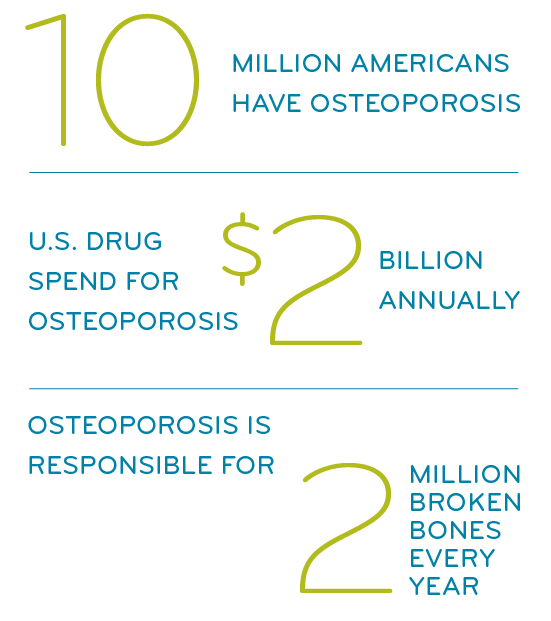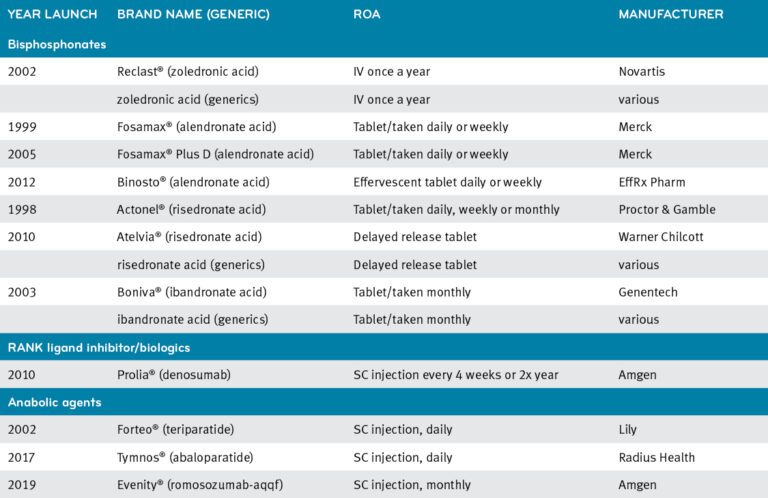Perspectives
Strategy for treating osteoporosis at high risk for fracture using MedDrive™
The focus will be to prefer zoledronic acid to maximize savings
February 24, 2022 The estimated mean cost of fractures on annual medical cost was $8,600; the average cost of drug treatment was $500 per treated patient. Encouraging the management and treatment of high risk osteoporosis is a standard of care.1
The estimated mean cost of fractures on annual medical cost was $8,600; the average cost of drug treatment was $500 per treated patient. Encouraging the management and treatment of high risk osteoporosis is a standard of care.1
What is bone remodeling?
The inside of a bone looks like a sponge. The outside is a hard shell. Bones are in a constant state of renewal. Old bone tissue breaks down to circulate in the blood calcium and other minerals that the body needs. New bone tissue is formed in a process called bone remodeling. This lets the bones supply the body with needed calcium while keeping the bones strong. After age 35, this bone breakdown happens faster than bone remodeling. With osteoporosis, this breakdown happens even faster. The holes in the sponge get larger and more numerous, making the bone weaker.3
Medications that treat osteoporosis
Exercise and supplements can help prevent osteoporosis. Treatments for established osteoporosis may also include exercise, vitamin and mineral supplements and medications.
Several classes of medications treat patients with high-risk osteoporosis.
Bisphosphonates dominate the treatment category. They are considered antiresorptive drugs because they stop the body from reabsorbing bone tissue. The bones keep all the bone remodeling they do, rather having that calcium available to go elsewhere in the body. A doctor may prescribe a bisphosphonate for three to five years or longer. The benefits of the therapy continue on, after the patients stops taking the medication.
Biologics: Denosumab is a monoclonal antibody – an artificial protein that binds to a specific receptor involved in bone remodeling. This receptor tells the body to break down old bone cells. Denosumab stops this message, so those old bone cells don’t break down.2
Anabolic agents: These products build back bone. They can be taken for a limited period of time.
 Many of these drugs come as tablets and are available in different strengths. They can vary in how often they are taken: daily, weekly or monthly. Some of the drugs come as injectables, which may be prescribed once a day, once every three months, to once a year. Depending on the benefit design, some of these drugs may adjudicate under the pharmacy benefit, others under the medical benefit.
Many of these drugs come as tablets and are available in different strengths. They can vary in how often they are taken: daily, weekly or monthly. Some of the drugs come as injectables, which may be prescribed once a day, once every three months, to once a year. Depending on the benefit design, some of these drugs may adjudicate under the pharmacy benefit, others under the medical benefit.
There are several indicators and tests that can be administered to determine a person’s risk for developing a facture including:
- bone density scans
- falls risk
- previous fractures
- medication use
If a patient is considered “high risk” or “very high risk” or their indicators worsen while on oral treatment, an injectable agent might be prescribed. This is the population that this strategy is geared towards.
Prime looks at integrated medical and pharmacy data for its Blue Plan clients; it can see all the osteoporosis drug claims data together and analyze use and spend. This is a strategic advantage in understanding and managing spend in this category. Costs per patient in this injectable drug category range widely, from $350/year to $30,000/year.7
When looking at Prime’s members receiving injectable treatment for osteoporosis at high risk for fracture, 21% of these members are treated with zoledronic acid. Prolia (denosumab) holds the majority of the market share at 78%. Anabolic agents account for the remaining <2%.7
MedDrive’s recommendation is to prefer generic zoledronic acid for osteoporosis in patients at high risk for fracture. Prolia (denosumab) and Evenity (romosozumab-aqqf) are non-preferred.
The launch of MedDrive signaled that Prime and its Blue Plan clients were going to get more aggressive about medical drug savings.
Prime’s recommended MedDrive strategy for bone remodeling for treating high risk osteoporosis is to prefer generic zoledronic acid over Prolia (denosumab) and Evenity (romosozumab-aqqf). Some of Prime’s Blue Plan clients already do this. Several others are now in the process of transitioning to this strategy.
Now that Prime has a made its MedDrive recommendation to clients, we anticipate market share to increase and savings to build over the next year. Prime’s clients may save $10 to $15 million annually executing this strategy.
MedDrive medical solutions is a complete toolkit
MedDrive leverages the collective strength of Prime’s client membership to help control medical costs. Client savings are obtained through:
- Lower cost alternatives within the same therapeutic class
- Lower net costs with shift of use from expensive medical drugs to lower cost alternatives, such as biosimilars
- Improved rebates from manufacturers
Prime’s Blue Plan clients are executing preferred drug programs are designed to save them hundreds of millions of dollars. We’ll continue to showcase these drugs and this analysis in coming weeks. For more information, contact your local Prime representative.
References
- Blume SW, Curtis JR. Medical costs of osteoporosis in the elderly Medicare population. Osteoporosis Int. 2011 Jun;22(6):1835-44. doi: 10.1007/s00198-010-1419-7. Epub 2010 Dec 17. PMID: 21165602; PMCID: PMC3767374. Accessed at: https://pubmed.ncbi.nlm.nih.gov/21165602/
- Osteoporosis Fast Facts. National Osteoporosis Foundation. Accessed at: http://www.bonehealthandosteoporosis.org/wp-content/uploads/2015/12/Osteoporosis-Fast-Facts.pdf
- Last reviewed 4-20-2020. Cleveland Clinic. Accessed at: https://my.clevelandclinic.org/health/diseases/4443-osteoporosis
- Using Prolia to Treat Bone Loss in People With Breast Cancer – GoodRx https://www.goodrx.com/conditions/breast-cancer/prolia-for-bone-loss-breast-cancer-medications
- Anabolic Therapies for Osteoporosis in Postmenopausal Women: Effectiveness and Value. By the Institute for Clinical and Economic Review (ICER). July 17, 2017. Prepared for California Technology Assessment Forum (CTAF). Accessed at: http://icerorg.wpengine.com/wp-content/uploads/2020/10/CTAF_Osteoporosis_Final_Evidence_Report_071717-1.pdf
- Drugs to treat osteoporosis: Comparing effectiveness, safety and price. September 2013. © 2022 Consumer Reports. Accessed at: https://www.consumerreports.org/cro/2013/09/osteoporosis-medications/index.htm
- Prime’s book of business
Related news
Perspectives
April 25, 2024
Drug Approvals Monthly Update: April 2024
This monthly update of United States (U.S.) Food and Drug Administration (FDA) approvals…
Perspectives
April 24, 2024
Prime/MRx resident wins AMCP Foundation Best Poster Award
Ai Quynh Nguyen, PharmD, was recently recognized for her research on opioid-prescribing patterns and outcomes
Perspectives
April 23, 2024
Expert Clinical Network Insights: April 2024
A look into our Expert Clinical Network (ECN) – part of Prime/MRx’s value-based approach to medical and pharmacy benefit management that offers access to more than 175 national and world-renowned key opinion leaders in multiple disease categories who provide expertise on challenging prior authorization case reviews, peer-to-peer discussions, drug policy development and formulary guidance